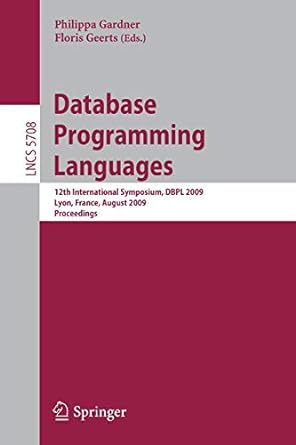Question
WRITE LC3 ASSEMBLER If we implement a runtime stack using an array, we dont need a dynamic link pointer to the activation record, so all
WRITE LC3 ASSEMBLER
If we implement a runtime stack using an array, we dont need a dynamic link pointer to the activation record, so all we need are spaces for parameters, the return value, the return address, and local variables.
A sketch of the program from Problem 1 into low-level pseudocode follows. You are to implement the pseudocode in LC3 assembler. (You dont have to stop at locations A and B in Problem 1.)
When calling RecSum, the stack should have S as the top element and N just below it. (Ill write this as ... N S [top to the right].) RecSum should begin by completing the activation record (stack = ... N S [space for result] R7) *. When RecSum returns, the stack should be ... N S result (because R7 was popped off to restore it).. The top-level call to RecSum is done by Sum, which is called by the main program. Sum should initialize the stack, set it to R7 N 0 and call RecSum. When RecSum returns, Sum should pop the returned value off the stack and return it (after clearing out the stack). Note: RecSum is written as a tail-recursive routine: Once the base case figures out what it wants to return, all of the recursive calls just return that same value.
Pseudocode
; ;
; recursively calculate sum(N) = 1 + 2 + ... + N ;
.ORIG x8000
; main calls sum(N), stores result in S ;
LD R0, N JSR SUM ST R0, S HALT
; prep for sum(N) ; R0 = sum(N) ; S = sum(N)
; N is a constant, S is space for result ; N .FILL 100 S .BLKW 1
; Top-level SUM retrieves N from R0, sets up the stack, and ; makes the 1st-level call to RecSum. On return we save the ; result, restore R7, clean up, and return. ; ; Sum and RecSum share register *** STUB ***, which points to the ; top of the stack. ; *** STUB *** (Any registers destroyed?) ; RecSum
SUM Init stack Push R7
Push N Push 0 JSR RecSum Save result into R0
stack = empty stack = R7 stack=R7N stack=R7N0 On return, stack = R7 N 0 result
stack = ... N S [top]
Restore R7
Clean up stack Return (JMP R7)
; RecSum(N, S) = S if N <= 0, else = RecSum(N-1, S+N) ; ; RecSum expects stack: ... N S [top], returns with ... N S result ; Relies on *** STUB *** = & top of stack ; *** STUB *** (Any registers destroyed?) ; ; In comments below, [result] means result has not yet been calculated ; RecSum
Push result space Push R7 if N <= 0 then .setresult=S else
. Calculate N-1 . Push N-1 . Calculate S+N . Push S+N
. JSR RecSum
stack = ... N S stack = ... N S [result] stack = ... N S [result] R7
. Get the recursive result (rec_res) . Set our result = recursive result . Pop off recursive result, S+N, and N-1
endif Restore R7 Return
stack .BLKW big number .END
stack = ... N S result R7 stack = ... N S result
; array holding stack
stack = ... N S result R7
stack = ... N S [result] R7 N-1
stack = ... N S [result] R7 N-1 S+N on return, stack = ... N S [result] R7 N-1 S+N rec_res
Implementing the stack: You get to decide how to implement your array stack.
Is top is at higher address? Lower address?
Does top point to next space to fill with a push? Or the value last pushed?
Recommended: Use a register to hold the address of the top of the stack. That way you can use LDR
and STR to access locations near the top of the stack.
Grading Scheme [35 points total]
[25 points] Roughly one point for each line of pseudocode in Sum and RecSum above.
[10 points] Comments with your assembler program (extremely important!). Use the lines of
pseudocode as the starting point for figuring out what to write for comments.
Step by Step Solution
There are 3 Steps involved in it
Step: 1

Get Instant Access to Expert-Tailored Solutions
See step-by-step solutions with expert insights and AI powered tools for academic success
Step: 2

Step: 3

Ace Your Homework with AI
Get the answers you need in no time with our AI-driven, step-by-step assistance
Get Started


